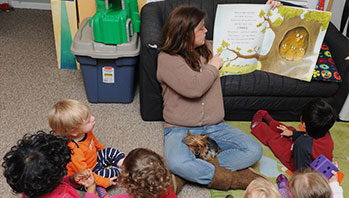- angry
- feel
- friend
- glad
- worried
MA Standards:
Literature/RL.PK.MA.1: With prompting and support, ask and answer questions about a story or a poem read aloud.
Language/L.PK.MA.4: Ask and answer questions about the meanings of new words and phrases introduced through books, activities, and play.
Head Start Outcomes:
Social Emotional Development/
Social Relationships 7: Recognizes and labels others’ emotions.
Approaches to Learning/Persistence & Attentiveness 1: Recognizes and labels others’ emotions.
Literacy Knowledge/Book Appreciation & Knowledge 2: Recognizes how books are read, such as front-to-back and one page at a time, and recognizes basic characteristics, such as title, author, and illustrator.
Literacy Knowledge/Book Appreciation & Knowledge 3: Asks and answers questions and makes comments about print materials.
PreK Learning Guidelines:
English Language Arts 2: Participate actively in discussions, listen to the ideas of others, and ask and answer relevant questions.
English Language Arts 3: Communicate personal experiences or interests.
English Language Arts 13: Relate themes and information in books to personal experiences.
English Language Arts 20: Generate questions and gather information to answer their questions in various ways.
Health Education 16: Recognize and describe or represent emotions such as happiness, surprise, anger, fear, sadness.
Read Together: Knuffle Bunny Too #2

© Commonwealth of Massachusetts, Department of Early Education and Care (Jennifer Waddell photographer). All rights reserved.
Hold up Knuffle Bunny Too by Mo Willems. Say, The author of this book is Mo Willems. Mo Willems is also the illustrator and photographer. He wrote the story and made the pictures.
Remind children that yesterday they looked at the pictures in the book and talked about what they thought was happening in the story. Say, Today we will read the story and see if what we thought was going to happen actually did happen.
Before You Read
Set a listening focus for children. Ask them to notice the different feelings the two girls have throughout the story. Say, Friends do lots of things together and sometimes they can feel happy, sad, or angry.
As You Read
Focus on the part of the book where Trixie and Sonja get their bunnies back and become friends. Ask questions such as:
- Why do you think the girls are hugging their bunnies? How do you think they are feeling? How do you know?
- Help children understand what worried means. Invite children to make a worried face with you. Ask, Why were the girls worried? Have you ever been worried? What were you worried about?
- Reread the sentence “I’m glad you got your bunny back.” Emphasize the word glad as you point to it. Ask, What do you think the word glad means?
After You Read
Talk about the different feelings the girls felt at different times in the story. Have children to share a time when they had the same feelings. Encourage all children to participate in the discussion.
Educator Tip: Some children may not have the right words to accurately describe how they are feeling. Be cautious of answering for children and labeling their emotions too soon. Teach a variety of emotion words so children can describe when they are frustrated, anxious, or embarrassed.
Educator Tip: Point to the word friend on the last page. Explain that Trixie and Sonja are now best friends. Ask children to reflect on any new friendships they have at school or outside of school.
Adaptation: Have children who have difficulty sitting for lengths of time move around and act out feelings with their bodies and their faces as you read the story.
English Language Learners: Review vocabulary from Knuffle Bunny Too with children. Point to objects from the book, or show pictures of the objects and have English Language Learners say the name of the object in their home language. Repeat the word they say, then have them say the name of the object in English after you and use the word in a sentence.
